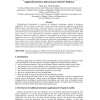JDCTA
2010
13 years 10 months ago
2010
Platform-based development is currently the dominant development method of enterprise application, but the features provided by current mainstream enterprise application developme...
SIGCOMM
2010
ACM
14 years 3 months ago
2010
ACM
In this paper, we tackle challenges in migrating enterprise services into hybrid cloud-based deployments, where enterprise operations are partly hosted on-premise and partly in th...
SE
2007
14 years 4 months ago
2007
Abstract: Today’s enterprise applications are based on numerous interrelated components that capture domain-specific, generic or infrastructural functionality. Each component is...
ER
2006
Springer
14 years 6 months ago
2006
Springer
Interoperability is a key property of enterprise applications, which is hard to achieve due to the large number of interoperating components and semantic heterogeneity. Platform-ba...
ASWEC
2006
IEEE
14 years 6 months ago
2006
IEEE
We propose a software development method for enterprise applications that combines the use of the structural concepts provided by problem frames, and the use of the UML notation. ...
CAISE
2004
Springer
14 years 6 months ago
2004
Springer
Interoperability of Enterprise Applications is a serious and multi-facetted problem. One of the tasks of the recently-started INTEROP Network of Excellence is to address this probl...
WECWIS
2003
IEEE
14 years 8 months ago
2003
IEEE
Enterprise Applications are increasingly moving towards providing web access to their users through "thin clients". There is a strong case for their integration using we...
EDOC
2003
IEEE
14 years 8 months ago
2003
IEEE
The architectural design of distributed enterprise applications from the viewpoints of different stakeholders has been proposed for some time, for example, as part of RM-ODP and I...
ASIAN
2005
Springer
14 years 8 months ago
2005
Springer
One of the main challenges in building enterprise applications has been to balance between built-in functionality and domain/scenario-specific customization. The lack of formal way...
IDEAS
2005
IEEE
14 years 8 months ago
2005
IEEE
Enterprise applications need to be highly available and scalable. In the past, this has required “stateless” applications, which essentially require the application to manage ...





